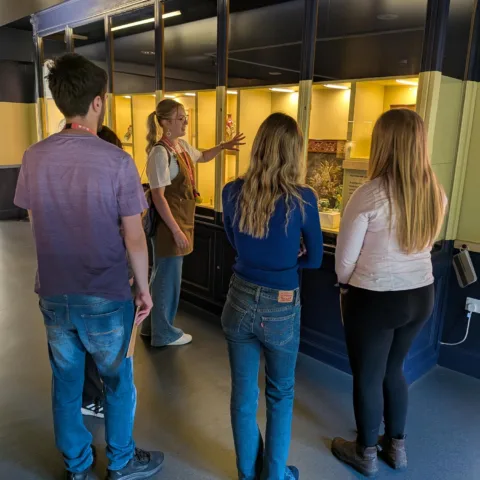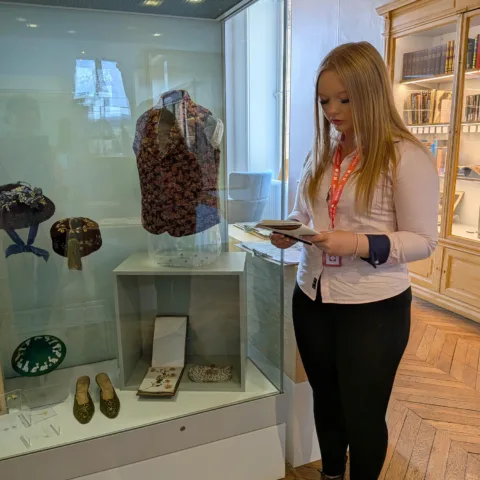The Bowes Museum Blog

Researching Sèvres Porcelain
The porcelain factory at Sèvres outside Paris has a prestige that is almost unparalleled amongst collectors and decorative arts institutions, particularly those that specialize in the 18th century. This is partly on the grounds of the style and quality of its products (though German specialists might prefer Meissen, and English collectors support Worcester and Chelsea), and on the grounds of historic importance, in that it was the property, and therefore the taste, of the most powerful king, and by extension the taste of the ruling classes, of Europe. However, it is not always realised that the porcelain is often particularly well-documented, both in that the object itself usually bears a date letter and painter’s mark, and the fact the extensive factory archives still exist, together with a range of outside documentation in the form of palace inventories and dealers’ lists. This makes it specially ‘researchable’ in decorative arts terms, giving insight into the dating, maker, pricing, and sometimes even the final client.
These issues came up with the recent gift of a very fine Sèvres cup and saucer to The Bowes Museum by Mr and Mrs. Philip Hodgson from the collection of his father Kenneth. It is immediately apparent that it is a piece (or rather, two pieces) of porcelain of the finest quality, carefully and elaborately decorated. The quality of the gilding is particularly noteworthy. The Bowes Museum has of course an extensive collection of Sèvres Porcelain – one of the largest in Britain- given by its foundress Joséphine Bowes, but few items of this quality. Though the extent of The Bowes Museum collections give its staff considerable expertise in their given fields, it is always helpful to discuss pieces with outside experts, in this case I am grateful to a Northern private collector for identifying the marks and clarifying the date of these pieces.
The cup and saucer are a gobelet litron et soucoupe of the second size. A gobelet is of course cup or goblet; a litron is a unit of measurement, a cylindrical wooden measure whose shape was imitated by the Sèvres factory for its standard cup shape. Soucoupe of course means saucer (Rosalind Savill, The Wallace Collection: Catalogue of Sèvres Porcelain, 1988,vol,II, p.501). In England, such cups are generally identified as coffee cans, but in France they seem to have been used for both tea and coffee. However this example is unlikely to have been used for anything at all, as its superb decoration places it in the class of the individually decorated ‘cabinet’ cup and saucer that went straight into the china cabinet on acquisition. Their purchase as such is recorded in the 18th century: the Reverend William Cole records that his friend Horace Walpole bought one at the dealer Poirier’s shop on their visit to Paris in 1765: ‘I was with Mr. Walpole one Day at a great shop in Paris, Mr. Poirier’s, where [Sèvres porcelain] was sold, & saw him give 10 Louis or guineas for a single Coffee cup, Saucer, & a little square Sort of Soucoupe, or under-saucer, to set them on; they were indeed the highest finished things of the kind that can be conceived: perfect Jewels that deserve to be set in gold Frames to be admired & looked at, but never to be used for Fear of breaking them ‘ (W. Cole, A Journal of my Journey to Paris in the Year 1765, London, 1931, pp.232-3). As far as I know, the term ‘cabinet’ cup and saucer is first used in the sale catalogue of the Bristol factory in 1780 (J.E.Nightingale Contributions Towards the History of Early English Porcelain, Salisbury, 1881/1973, pp.103, 106).
The Sèvres factory made gobelets litron in five different sizes, any of which could be specially decorated as a gift to go into the china cabinet, or more simply decorated in sets to go into tea and coffee sets. This cup is of the second size, meaning that there is one size larger in this shape and three smaller. It is decorated in a rich even blue all over ‘ground’ colour that the factory developed in the late 18th century , the new blue or bleu nouveau, or bleu du roi introduced in 1763, and associated with Sèvres ever since. That has a more even surface than the former patchy and erratic bleu lapis of the mid 18th century. The central panels or réserves are both painted with flowers and fruit in an incredibly skilful manner. However the gilding is exceptional, and reveals several layers of gold (each necessitating a separate firing) which would be chased and tooled in the manner of sold metal.
The marks on the base tell the whole story: interlaced Ls for Louis XVI, King of France, and main supporter of the factory; a date letters dd for 1781 [formerly read as jj, as an old label on the base attests]; and finally the letter B and a strange h/g character. These are identified by David Peters (Decorator and Date Marks on 18th Century Vincennes and Sèvres Porcelain) as the marks of Jean-Pierre Boulanger, a gilder who worked at the factory from 1754 to 1785, and Jacques-Francois-Louis de Laroche, who worked at the factory from 1758 to 1802 (what a long career!) as a painter of flowers, ground colours and patterns.
Work by both these decorators is recorded in pieces in the royal collection ‘Laroche’s colours are bright, fresh and strong. In his painting of leaves, the veins can be clearly seen’ [Geoffrey de Bellaigue, French Porcelain In the Collection of Her Majesty The Queen, 2010, p.968]. The workmen’s records at the factory have yet to be fully explored, though a listing (with dates) is available at the web-site of the French Porcelain Society (https://thefrenchporcelainsociety.com)
Who would have been the lucky recipient of this cup and saucer in 1781? At this point, the published records give out, though it is not impossible that a research visit to the meticulously kept Sèvres archives would trace the cup and saucer in the kiln records, and even the price it was sold for.

illustrations; Sèvres cup and saucer, 1781, decorated by Boulanger and La Roche. Diameter of saucer 14cm; height of cup 7 cm
Presented by Mr and Mrs Philip Hodgson in memory of his father Kenneth. The Bowes Museum no. 2011.16
By Dr. Howard Coutts, Keeper of Ceramics







